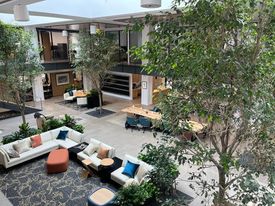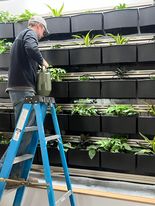
We are used to measuring everything in percentages – successes and failures in business, the quality of education and health care, even happiness. We measure in percentages the damage we ourselves cause to nature. The climate is changing, and with it the percentages are changing, too.
The Iowa Natural Heritage Foundation had this to say in its Iowa Climate Assessment report: “In the last three decades Iowa weather has become more extreme in many ways: annual rainfall has increased, seasonal rainfall at critical times for agriculture have increased, humidity has increased in all seasons, summer maximum temperatures have decreased, winter temperatures have increased, summer nighttime temperatures have increased, and the list goes on. Climate change is creating negative impacts on Iowa’s economy and communities.”
And climate change is one of the top issue areas at the Stanley Center for Peace and Security, a private foundation based in Muscatine, Iowa. The center works across countries and sectors to aggressively pursue the goal of limiting the increase in global temperatures to 1.5°degrees Celsius (or 2.7 degrees Fahrenheit) above preindustrial levels.

To do its part, the center aimed to create a headquarters that is one of the world’s greenest buildings, ecologically sustainable and environmentally friendly. This is how the building of the future appeared. There are only 30 like it in the world. In Muscatine, it is a home and office for 25 people.
“Buildings contribute about 40 percent of carbon emissions in the world and through the Living Building Challenge you are able to create a building that does less bad and also does good for the environment, said Mark Seaman, the Stanley Center’s vice president and director of communications. “So we generate all of our electricity. All of the rain water that falls is kept and used for drinking water and other purposes, and it’s a place where we want the inhabitants to feel healthy, happy.”
Why does building construction pollute so much? When we look at building materials such as PVC pipe that are created using toxic processes and petroleum, they are just very harmful extractive of the environment.
“The Living Building Challenge encouraged us to choose materials that aren’t harmful for the environment: copper piping and naturally occurring wood products. We’re not bringing in materials from faraway places, because of course that shipping and that supply chain are all part of contributing to emissions,” Seaman says.
Seaman adds that they’re able to take some of the lessons that they’ve learned from going through this process and apply them to other projects. The Stanley Center hopes to be lowering the barrier for others to use more environmentally sustainable and ecologically safe practices in construction.

Here are some more numbers from the Natural Heritage Foundation’s Iowa Climate Assessment: “The Iowa derecho on August 10, 2020 caused a swath of damage to outbuildings, barns, grain bins, homes, mobile homes, power lines and 7 million trees in about 3 hours that cost over $11 billion to clean up and left behind damage to crops estimated at $500 million.”
Are Americans ready to think about ecological topics?
“If they’re not they need to be,” says Seaman. “Everybody has a role to play in climate change. And I think that it’s definitely something that everyone is aware of. This is a significant global challenge. We might not agree on the ways to confront it, but everyone knows it’s happening, and we need to move, we hope, to influence those who don’t agree.”



